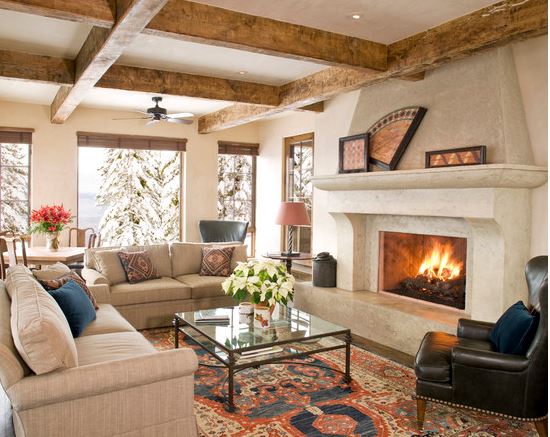ANTIQUE CAUCASIAN RUGS
Caucasian rugs get their name from the area in which they were made – the Caucasus. It is no wonder that the weavings of the 85 subgroups of Caucasian tribal rugs are enjoying rapidly growing popularity among both Oriental rug collectors and lovers of folk art.
Caucasian rugs are best known for featuring bold geometric and tribal designs in primary colors. The rugs from the Caucasus are primarily made of materials that are (or were) particular to their tribal provinces and some of the styles that are “typical” or better known to the Caucasus region are Shirvan, Dagestan, Kuba, Kazak rugs.
The vast majority were woven circa 1825 to circa 1890 with exciting departures from the traditional pattern language and awe-inspiring color shifts. Characteristically in excellent floor condition.
The Caucasus is a region that produces distinctive rugs since the end of the 18th century and the antique Caucasian rugs are primarily produced as village pieces rather than the fine and intricate city productions. All caucasian rugs are made with the Turkish or Giordes knot. “Kazak” carpets are not from Kazakstan (which is on the other side of the Caspian Sea) – but are from an area in what is now Armenia. The colors of older Caucasian Rugs are mostly made from natural materials found in the respective tribal regions. Most older Caucasian rugs are “all wool” – not only the knotted pile, but the warp and weft threads are usually made from hand spun woolen yarn or goat hair However, one can sometimes find older carpets (and more frequently in some newer examples) with cotton warps and wefts. Warp threads can be made of undyed light yarn in one area, and dark or mixed in another. Goat hair is also seen for the warp threads, but never for the pile. Weft threads can be different colors: rusty red/brown, blue or white. The number and colors of selvages often can be an identifier to the area of origin.
Types of Caucasian Rugs
Akstafa Rugs
Located in the Northwestern part of Azerbaijan and today is a major source of new rugs with neo-Caucasian patterns. The true Akstafa rugs is also related to the Shirvan and are often called Shirvan-Akstafa. A typical feature of the Akstafa design is the bird like creatures with a long neck and a peacock’s tail and a bottom like the teeth of a handsaw. Sometimes the bird has widely spaced legs. The same bird also shows up in Shirvan designs. Older Akstafa rugs are usually proportionally long, roughly knotted and have a repeating design of crude cocks and polygonal medallions longitudinally. There are usually 3 warp threads – light gray or brown.
Armenian Rugs
Armenian rugs are usually defined by the names of sub-regional rug making areas such as the Sevan, Kazak Erivan and Karabakh groups (defined later).
Avar Rugs
The Avars are one of the largest of the Dagestan tribes and make a rug with a characteristic design of repeating rows of stepped polygons – without hooks. The main borders are usually made up of diagonal stripes. The warp and weft threads are light or mingled with light brown yarn. Usually has a double selvage with the outermost of a white color.
Baku-Chila Rugs
Baku is the capital of Azerbaijan and came under Russian protection in 1723 under Alexander II. Usually has single or multiples of stepped octagons often surrounded by a field of Botehs or sometimes in Kuba rugs, carnations.
Bidjov Rugs
Often has a cross and a crescent depicted in an abstract geometric pattern. Usually has a running dog border and triple dark blue selvages.
Bordjalou or Borchalo Rugs
Bordjalou is the northernmost town associated with production of Kazak rugs. Caucasian rug from this area often incorporate octagons with latch-hook edges. Borders used include the running dog, the T-Meander, and a unique reciprocal arrow border design. The warp is usually light color and alternating high and low due to varying weft tension (results in longitudinal ridges on back) Weft threads are rusty red. Quadruple selvages- wrapped two brown and two red. Often a cross motif is seen.
Cheleberd Rugs
The most typical design is often erroneously referred to as an “Eagle Claw Kazak” or “Sunburst Kazak”. In fact, the figure is really a flaming cross – giving a clue to the Christian history of the Armenians who make them. The faded red dye is made from the madder root, a tint found only in the Karabagh district. The fishbone motif and the crab garlands in the border are typical. Long rugs of this type are rarer. They often have small animal and human figures worked into the field and dated- sometimes indicating that the rug was a wedding gift. Design influence from Northwest Persia.
Chondoresk Rugs
Often called a “Cloud Kazak” with octagon including a figure which looks like a Chinese cloud design, but which is a highly stylized Greek Omega figure left by Alexander the Great! The rugs are especially colorful.
Dagestan Rugs
Dagestan is located in the Northeastern corner of the Caucasus, and the many tribes including Kuba, Shirvan, Kuba, etc. are mostly Muslim. The specific districts are described separately.
Gendje Rugs
Gendje was the name of the Khanate of the same name, but was converted eventually to Elisavetpol and then to Kirovabad. Armenians were the rug makers, and these rugs are often referred to as “Genje-Kazak”. Some were typically narrow and long and used for hall runners and for stairs. Border ornaments can be running dogs, crosses, leaves, meanders, etc. The field were characteristically diagonal stripes of varying colors filled with almost any kind of figure – except rarely the boteh.
Georgian Rugs
Georgian Rugs borrow designs from the various Kazak groups. One can sometimes find an old prayer rug, with a Georgian cross in the niche! Warps are undyed light wool weft threads light brown and are 2 to 4 in number. Double or triple selvages and the fringes are sometimes plaited.
Karabagh Rugs
Karabagh rugs in the 19th and 20th century was influenced by design requirements from Europe including the “Gul Franki” design. The cross is a common ornament and is often found on Muslim prayer rugs! The quality of Karabagh rugs can vary wildly from super fine to really rough. The designs, dyestuffs, wool types and knotting techniques vary according to the specific tribal area.
Karachoph Rugs
Characteristic design includes an octagonal medallion surrounded by four rectangles with star figures inside. Borders highly decorative. The warp is usually undyed gray yarn and wefts are triple and rusty brown selvages single
Karagashli Rugs
Usually bright colors on dark fields with mystical animals and sometimes crosses. Usually densely knotted and highly prized by collectors.
Konangulkent or Konagkend Rugs
Located in the Kuba district, Konangulkent rugs bear an Armenian hallmark and often include artistic crosses. The design in the borders often show S-s with a line through them making them into D-s standing for Dios=God. One sometimes find “rocket ships” spaced along the edge of the field with stylized “blast” coming out of the base. Minor borders of carnations are common.
Kuba Rugs
Kuba rugs come in many qualities, but non-are sub-standard. Patterns can repeat themes from neighboring Perpedil, Konagkend, and Seichur, but a Kuba usually has a border with a variant of the “Running Dog”, stars, carnations, and/or flowers. The field is usually a dark indigo. Warps are light or light brown, wefts are double and light, selvages double and light.
Lenkoran Rugs
Lenkoran is located on the Caspian on the southeast corner of Azerbaijan. The Lenkoran rug characteristically has a series of “tortoise” figures. The ground or field color is usually dark. The warp is dark or brownish, with double weft threads of brown or rusty red. Persian Malayer rugs using the same tortoise figure use single wefts and the wefts are visible.
Lori Pambak Rugs
From Georgia. Warp light yarn; two brown weft threads
Marasali Rugs
Unusually fine prayer rugs with distinctive Botehs each with zigzag edges. Border designs vary widely. Very fine quality and clipped thin. Warps can be light yarn and of varying colors wefts and double selvages are always white.
Perepedil Rugs
One design is found consisting of: rams horn in field; horizontal crosses along inner guard band with ends of shorter part of cross bent like coat hanger; animal figure with 6 legs; and many other motifs dispersed through field. Quality can vary from super fine to very rough. The warp, thin weft threads and selvages are of light undyed woolen yarn. Copies are sometimes made in Persia using silk warps.
Seichur Rugs
Seichur rugs are from the northern part of the Kuba area 30 Km from Dagestan. Their rugs are often distinguished by repetitive “St. Andrews” cross motifs. The running dog border is also a common characteristic of a Seichur rug. These caucasian rugs are usually specially fine with a high knot count. The employ wool warps and sometimes cotton wefts. Older Seichur tend to be elongated. Seichur rugs were also made with all-over flower “Gul Franki” motifs to please the European trade in the 19th century.
Sevan or Sewan Rugs
The Sevan rugs have very distinctive design- usually with a large stylized cruciform medallion, with butterfly wings (sometimes called a Shield or Butterfly Kazak). The center part of the medallion is usually a rectangular figure with hooks and decoration. In each corner is usually a tree figure or some other motif. The field is often filled with animal figures, “S” shapes, rosettes, flowers, stars etc.
Shirvan Rugs
Shirvan is one of the principal weaving areas of the Caucasus stretching from the central east coast some 400 km inland and encompassing towns which produce particular design variations common to the Shirvan group. These include Bidjov, Marasali, Khila, Surahani, Baku and Saliani. The Shirvan rugs are noted as being some of the finest rugs from Caucasian. They are usually thin and densely knotted. The warp threads are usually light and undyed brown sheep’s wool spun together. The wefts are light and thin, and selvages are usually white over double or triple threads. Cotton wefts are also seen, as are silk wefts
Soumak or Sumak Rugs
When one talks about a flat woven Kelim- one almost always hears mention of the kelims from Soumak. They are distinguishable by the fact that the pattern is visible only from one side- with the reverse often having threads of yarn 2 to 4 cm long left hanging on the back. The Soumak kilims are heavy and stiff and make a great floor rug. They are found in bag faces, animal covers and have been used as curtains and bed covers. Designs are almost always bold and colorful and employ many of the design patterns of the knotted Caucasian rugs.
Talish Rugs
Talish borders on Persian Azerbaijan and encompasses Lenkoran and Moghan rug areas. These rugs are noted for their elongated shape- often in the form of a runner. A common motif is the St Andrew’s cross, separated by octagonal medallions. Occasionally the Lenkoran Tortoise motif replaces the St Andrews cross. Warps are a mixture of undyed beige and Brown wool, wefts are usually 2 strands of gray cotton.
Our inventory of collectible Caucasian rugs includes first-rate examples of the more loosely woven, starkly geometric tribal carpets from the high mountain regions of the Caucasus, including Kazak, Karabagh and Gendje. Equally enchanting is our Caucasian rugs that were woven on the Caucasus’ lower slopes descending toward the Caspian Sea, with their significantly finer knotting and more elaborate geometric to stylized floral designs. Our lowlands Caucasian rugs include the stellar representatives of the important subgroups of Shirvan, Kuba, Daghestan, Lesghi, Akstafa and many others. Collectible prayer rugs, dramatic long rugs and difficult-to-find runners are included. All are careful chosen works of art that emanate the spirit of celebration and deep understanding of life possessed by the finest weavers of the Caucasus Mountains.
Source:
http://www.bukhara-carpets.com/






